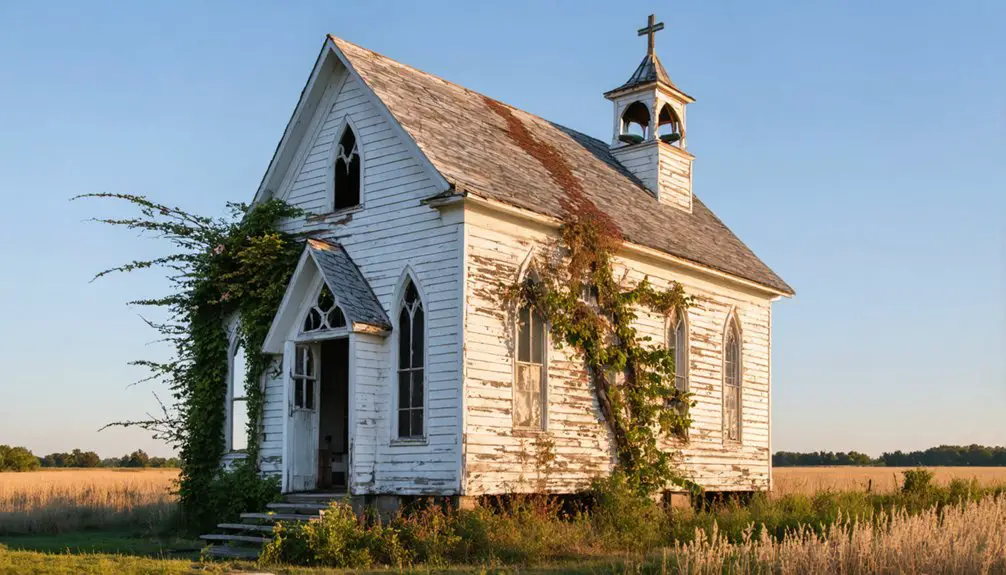You’ll find Woolworth, a ghost town in Lincoln County, Mississippi, along the former Mississippi Central Railroad line. The unincorporated town flourished in the early 1900s with a 48-car rail siding, bustling depot, sawmill, and general store. Up to 39 trains passed through daily during its peak, but the railroad’s closure in 1967 led to the community’s decline. Today, the old general store stands as a silent sentinel, guarding stories of this once-vibrant transportation hub.
Key Takeaways
- Woolworth, Mississippi became a ghost town after the Mississippi Central Railroad ceased operations in 1967, ending decades of economic prosperity.
- The town flourished as a railroad stop with a 48-car siding and busy depot, serving as a vital transportation hub.
- A prominent sawmill and general store anchored the local economy until rail service termination led to business closures.
- Despite never being officially incorporated, Woolworth was a significant commercial center between Brookhaven and Silver Creek.
- Today, only a few structures remain, including the converted general store, representing the town’s historical significance in rural Mississippi.
The Rise of a Railroad Stop
As the Mississippi Central Railroad expanded its operations in the early 1900s, Woolworth emerged as an essential stop between Brookhaven and Silver Creek.
The strategic expansion of Mississippi Central Railroad transformed Woolworth into a vital transportation link connecting major regional centers.
You’ll find that railroad history shaped the town’s identity, with its impressive 48-car siding and bustling depot serving as the heart of local commerce.
While Woolworth never officially incorporated or established a post office, it didn’t need these formalities to thrive. The railroad stop attracted important businesses, including a sawmill that relied on the tracks for shipping lumber. The old general store remains standing today, serving as a storage facility for its current owner.
You can imagine the daily scenes of passengers boarding trains while workers loaded freight cars nearby. The depot’s strategic position made it a significant link in northeast Lincoln County’s transportation network, transforming this rural spot into a noteworthy hub for both travelers and commerce. Today, it stands as a ghost town in Mississippi, reflecting the broader pattern of abandoned rural communities across America.
Life Along the Mississippi Central Line
You’d have found Woolworth bustling with activity as a commerce hub along the Mississippi Central Line, where freight handlers loaded cotton bales and agricultural goods while passengers boarded trains bound for regional destinations.
The daily rhythm of arriving and departing trains shaped local schedules, with merchants and residents timing their business around published timetables. During its prime, the Casey Jones Museum showcased the area’s rich railroad heritage from its home in the Water Valley depot. The railroad’s impressive fleet of 63 locomotives kept commerce flowing steadily through the town.
Life near the tracks meant you were connected to a wider world of commerce and social opportunity, as the railroad brought new goods, visitors, and economic possibilities to this small Mississippi town.
Railroad Commerce Hub
While the Mississippi River dominated early trade routes, the Mississippi Central Railroad transformed the region’s commercial landscape after its 1852 charter. This railroad expansion created the first rail connection between the Great Lakes and Gulf of Mexico, revolutionizing how you’d move goods across the region. Walter Goodman served as the railroad’s first president, leading its vital establishment.
The commerce evolution reshaped local economies, particularly in towns like Holly Springs and Water Valley. The Columbus & Greenville Railway established crucial rail service in the 1880s, connecting additional trade routes across the state.
- You’d find the railroad’s headquarters in Holly Springs for the first decade before its move to Water Valley in 1868.
- Cotton farmers could now bypass slow wagon transport, reaching New Orleans brokers efficiently.
- Local entrepreneurs seized opportunities as small towns became vibrant market centers.
- The rail line’s integration with river ports created a powerful transportation network.
Daily Transit Operations
The Mississippi Central Railroad‘s daily operations painted a vivid picture of 19th-century industrial progress, with up to 39 trains thundering through Water Valley each day at the line’s peak.
You’d find a mix of passenger trains and specialized freight services, including the swift “banana expresses” that transported perishable cargo.
Transit schedules kept the line humming with precision as steam locomotives connected Tennessee to Mississippi, while freight logistics guaranteed cotton, fertilizer, and wood products reached markets from the Great Lakes to the Gulf Coast.
Telegraph operators coordinated train movements from well-staffed depots, which served as bustling community hubs.
The railroad’s standard gauge tracks facilitated smooth operations, with roundhouses providing essential maintenance for the steady stream of locomotives that kept commerce flowing through the heart of Mississippi. Today’s Mississippi Central Railroad maintains this legacy on its 51 miles of track, continuing to serve the region’s transportation needs. The line now serves as a vital link for wood products and fertilizer transport, maintaining its historical role in regional commerce.
Community Along Tracks
Life along Mississippi Central’s iron pathway flourished as communities like Woolworth sprang up beside the tracks in the mid-1800s.
You’d find a vibrant railroad community where merchants, farmers, and railroad workers from diverse backgrounds shaped the cultural heritage of these trackside settlements.
The heartbeat of daily life centered around the rail depot, where you’d experience:
- Cotton traders negotiating deals for transport to distant markets
- Irish, German, and Finnish immigrants working alongside locals in maintenance yards
- Telegraph operators relaying messages between towns and cities
- Merchants operating shops that served both travelers and residents
Despite segregation laws affecting African American residents after 1888, these railroad communities fostered economic growth and connected isolated agricultural regions to broader markets, transforming the landscape between the Gulf Coast and Tennessee.
The Illinois Central Railroad became a dominant force in the region after acquiring local lines in 1877, further strengthening these communities’ economic ties.
Like many lumber company railways that emerged during this period, these settlements became crucial hubs for logging and shipping operations throughout the state.
Economic Foundations and Local Industry
Established as a bustling stop along the Mississippi Central Railroad in the early 1900s, Woolworth’s economic foundations rested firmly on its role as a transportation hub and industrial center.
You’ll find evidence of its economic resilience in the 48-car rail siding and busy depot that served passengers and freight alike, connecting the town to essential regional trade routes.
The timber economy thrived through a prominent sawmill operation, which provided jobs and processed local forest resources. Supporting businesses, including a general store and blacksmith shop, created a self-sustaining commercial ecosystem.
These establishments served both town residents and railroad operations, while the sawmill’s output found its way into local construction.
When automobile transportation grew and rail service declined, Woolworth’s industrial base crumbled, leading to the closure of crucial businesses.
Transportation’s Impact on Community Growth

You’ll find that Woolworth’s rise and fall hinged entirely on transportation, beginning with the Mississippi Central Railroad‘s establishment of a stop and 48-car siding that drove the town’s early growth in the late 1890s.
The community’s fortunes shifted dramatically when new automobile highways bypassed the settlement, reducing its role as a transport hub and initiating a decline in local commerce.
The final blow came when the Mississippi Central Railroad ceased operations through Woolworth, effectively shuttering the train depot and forcing the closure of transportation-dependent businesses like the sawmill.
Railroad Drives Initial Growth
When the Mississippi Central Railroad began operations in 1897, Woolworth emerged as an important stop along its route between Brookhaven and Silver Creek. This railroad history marked a significant economic change, as the town quickly developed around the rails that would shape its destiny.
You’ll find Woolworth’s early growth directly tied to its impressive railroad infrastructure, which included:
- A bustling train depot serving as the town’s central hub
- A substantial 48-car rail siding for managing freight
- An active sawmill operation supported by rail transport
- Important worker settlements and general stores near the tracks
The railroad transformed Woolworth from a rural outpost into a thriving transport node, connecting local industries to broader markets.
You can trace the community’s prosperity to this crucial rail connection that moved cotton, timber, and other commodities while bringing new workers and economic opportunities.
Road Networks Bypass Town
Although Woolworth initially thrived as a railroad hub, the town’s fate shifted dramatically as new road networks bypassed it entirely in favor of direct routes between Brookhaven and Silver Creek.
The road impact proved devastating, as traffic diversion reduced local commerce and eliminated essential foot traffic that businesses relied upon.
You’ll find that this transportation shift fundamentally altered the town’s economic prospects. The sawmill closed due to reduced accessibility, while the general store and blacksmith shops lost their customer base.
Without highway access, Woolworth couldn’t attract new residents or businesses during the automobile era. Like many communities cut off from evolving transportation networks, the town’s isolation led to depopulation and commercial decline, transforming a once-bustling railroad stop into another Mississippi ghost town.
Transportation Evolution Kills Commerce
The termination of Mississippi Central Railroad service in 1967 dealt a fatal blow to Woolworth’s commercial viability, marking the end of seventy years of rail-based prosperity.
You’ll find that transportation dependency shaped not just Woolworth’s rise, but its ultimate demise.
The shift from rail to automobiles created severe economic isolation as new roads bypassed the town completely.
Consider these critical impacts:
- The sawmill, Woolworth’s largest employer, shut down when rail shipping ended
- Local businesses serving rail passengers and freight operations lost their customer base
- The train depot’s demolition symbolized the permanent end of rail commerce
- Residents relocated as jobs vanished and commercial activity ceased
Without its transportation lifeline, Woolworth couldn’t sustain its economy, joining other Mississippi ghost towns whose fate was sealed by changing transit patterns.
Architectural Legacy and Surviving Structures

Railroad infrastructure shaped Woolworth’s architectural footprint during its brief existence as an unincorporated Mississippi settlement. The town’s architectural significance centered around its train depot, general store, sawmill, and blacksmith shop – all positioned strategically along the Mississippi Central Railroad tracks.
The railroad dictated Woolworth’s layout, with key structures like the depot and general store arranged purposefully along the tracks.
Today, you’ll find only a handful of structures preserving Woolworth’s community heritage. The general store and blacksmith shop still stand beside the tracks, though they’ve been converted to storage spaces.
Two houses built after the town’s decline showcase the resourceful spirit of local builders – one constructed north of the tracks by the sawmill owner, and another built from reclaimed materials including depot boards and schoolhouse beams from nearby Heucks Retreat.
These surviving buildings tell the story of adaptation and preservation in rural Mississippi.
The Decline of Small-Town Mississippi
Mirroring broader rural trends across America, Mississippi’s small towns face unprecedented population decline as residents seek opportunities elsewhere.
From 2010 to 2020, 64 of Mississippi’s 82 counties saw their populations shrink, with the Delta region hit especially hard by double-digit losses.
Today’s population trends paint a stark picture of small-town Mississippi’s transformation:
- Working-age residents are relocating to urban areas and suburbs, particularly around Jackson and the Gulf Coast, where economic opportunities are more abundant.
- The exodus has left aging populations behind, leading to more deaths than births.
- Traditional industries like cotton farming can’t sustain local economies anymore.
- Communities struggle with diminishing tax bases, making it harder to maintain services and infrastructure.
This demographic shift threatens the very survival of Mississippi’s rural heritage and small-town way of life.
Historical Significance in Lincoln County
Among Lincoln County’s vanished communities, Woolworth stands as a compelling reflection of Mississippi’s evolving landscape of commerce and transportation.
You’ll find evidence of economic shifts in the remnants of its general store, blacksmith shops, and demolished train depot – structures that once marked Woolworth as a crucial railroad stop between Brookhaven and Silver Creek.
The town’s story showcases remarkable community resilience through decades of change.
While the sawmill’s closure and shift from rail to automobile travel ultimately led to Woolworth’s decline, its preserved buildings tell a deeper tale.
These surviving structures document the broader patterns of rural Southern life, where railroad-dependent towns adapted or faded as transportation networks evolved.
Today, Woolworth’s physical heritage continues to provide valuable insights into Lincoln County’s economic and social transformation.
Preserving Memories of a Bygone Era
Despite the physical decline of Woolworth’s structures, dedicated local residents and historians have worked tirelessly to preserve the town’s memory through diverse grassroots efforts.
You’ll find memory preservation taking shape through community storytelling, digital archives, and the adaptive reuse of original materials in nearby homes.
Local efforts to maintain Woolworth’s legacy include:
- Informal oral histories passed down through generations of residents
- Collection and digitization of historical photographs and documents
- Protection of remaining structures like the general store and blacksmith shop
- Integration of Woolworth’s story into local school curricula and heritage trails
Through these preservation initiatives, you’re witnessing how a community can keep its history alive, even as physical remnants fade.
Local historians continue documenting Woolworth’s role in Mississippi’s railroad era, ensuring its story endures for future generations.
Modern-Day Remnants and Rural Heritage
While many rural Mississippi ghost towns have vanished entirely, Woolworth’s physical remnants offer you a compelling glimpse into early 20th-century life.
Unlike many vanished Mississippi ghost towns, Woolworth stands as a rare window into the state’s early 1900s small-town heritage.
You’ll find the old general store and blacksmith shops still standing, now repurposed for storage. Even the demolished train depot lives on through Luke Smith’s home, built from its reclaimed materials.
This ghost town’s evolution reflects broader changes in rural Mississippi, where automobile culture bypassed once-bustling rail stops.
While the original depot and passenger service are gone, the surviving structures tell a significant story of rural preservation.
Through adaptive reuse and local recycling of materials, Woolworth’s heritage endures, providing tangible connections to an era when railroads, retail commerce, and skilled trades defined small-town Mississippi life.
Frequently Asked Questions
What Is the Origin of the Town’s Name Woolworth?
You’ll find the name’s significance isn’t definitively documented, though historical linguistics suggest it likely borrowed from F.W. Woolworth’s famous retail brand during the railroad stop’s early 1900s commercial development.
Were There Any Schools or Churches in Woolworth During Its Existence?
You’ll find evidence of Woolworth education through a schoolhouse that served the community, with its beams later repurposed in local homes. While churches likely existed, there’s no direct documentation of them.
What Was the Peak Population of Woolworth at Its Height?
Like whispers from ghost stories lost to time, you won’t find exact numbers, but based on the town’s infrastructure and railroad operations, the peak population likely reached only 200-300 people before decline began.
Did Any Notable Historical Events or Figures Emerge From Woolworth?
You won’t find any famous residents or significant historical figures from this location. Records don’t show notable events either – the town’s historical significance centered purely on its role as a railway stop.
Are There Any Documented Paranormal Activities in Woolworth’s Abandoned Structures?
You won’t find any verified ghost sightings or paranormal investigations in these structures. There’s no documented supernatural activity, and private ownership of the buildings limits access for potential investigations.
References
- https://en.wikipedia.org/wiki/Woolworth
- https://www.gothichorrorstories.com/journal/winfield-hall-what-are-the-mysterious-secrets-of-f-w-woolworths-haunted-long-island-home/
- https://mississippifolklife.org/articles/haunted-by-a-ghost-town-the-lure-of-rodney-mississippi
- https://kids.kiddle.co/List_of_ghost_towns_in_Mississippi
- https://fiveanddimelofts.com/history-of-woolworths-five-and-dime/
- https://sites.rootsweb.com/~mstttp/woolworthgt.htm
- https://www.historic-structures.com/ms/clarksdale/woolworth_building.php
- https://en.wikipedia.org/wiki/Charles_Sumner_Woolworth
- https://www.americanheritage.com/1960-sit-woolworths
- https://en.wikipedia.org/wiki/Mississippi_Central_Railroad



